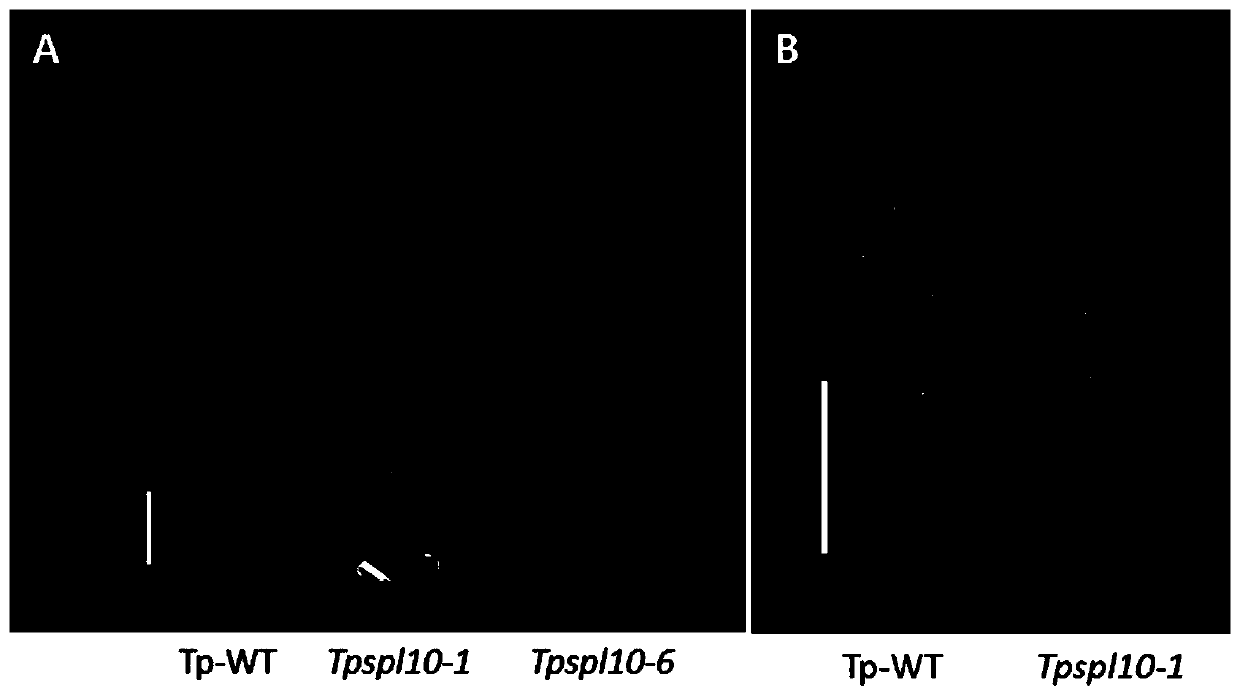Transcription factor gene Osspl10 of Oryza sativa and application of transcription factor gene Osspl10
A rice transcription factor and gene technology, applied in the fields of application, genetic engineering, plant gene improvement, etc., can solve the problems of rice SPL gene lack of systematicness, lack of understanding of the impact of yield-related traits, etc., to achieve large application potential, panicle size Reduce and promote the effect of breeding
- Summary
- Abstract
- Description
- Claims
- Application Information
AI Technical Summary
Problems solved by technology
Method used
Image
Examples
Embodiment 1
[0036] A kind of rice transcription factor gene Osspl10 of the present invention, described rice transcription factor gene Osspl10 has following nucleotide sequence:
[0037] (1) The nucleotide sequence of the rice transcription factor gene Osspl10 is as shown in SEQ ID NO: 1, or
[0038] (2) The nucleotide sequence is a nucleotide sequence similar to the DNA sequence shown in SEQ ID NO: 1 with a degree of similarity ≥ 95%, or
[0039] (3) The function of the nucleotide sequence is equivalent to a subfragment of the DNA sequence shown in SEQ ID NO: 1, or the DNA sequence shown in SEQ ID NO: 1 is replaced, deleted or increased by one or more nucleosides Nucleotide sequences that encode the same amino acid sequence.
[0040] The present invention relates to a DNA fragment of Osspl10 gene of rice. The DNA fragment of this gene is shown in the sequence table as SEQ ID NO:1. The Osspl10 gene can encode a transcription factor of the SPL family, and its amino acid sequence is show...
Embodiment 2
[0051] Target Design of Osspl10 Gene
[0052] Such as Figure 1 to Figure 3 As shown, using the TP309 genome and public database sequencing species Nipponbare as the reference sequence, according to the characteristics of the specific recognition sequence of the CRISPR / Cas9 system, a perl language program was written to screen suitable targets, and the qualified results were manually screened The site with the best specificity and located in the exon sequence at the front of the gene was selected as the target for subsequent experiments.
Embodiment 3
[0054] Construction of CRISPR / Cas9 expression vector
[0055] Add the cohesive end sequence and protective bases after digestion to the target sequence and complementary sequence, as the primer sequence sgRNA-F / sgRNA-R and artificially synthesize it. For the sgRNA-F / sgRNA-R sequence, refer to the sequence listing, the sgRNA-F sequence is shown in SEQ ID NO:3, and the sgRNA-R sequence is shown in SEQ ID NO:4. Take the synthesized primers sgRNA-F / sgRNA-R and dilute each 4 μM to 25 μL, and perform annealing reaction in the following procedure: 95°C for 3 minutes; 95°C to 25°C for slow cooling; -1°C for 30 seconds; 16°C for 5 minutes.
[0056] The annealed primer double-stranded DNA fragment is further phosphorylated. The phosphorylation reaction system was as follows: 2 μL of 10×T4 nucleotide kinase buffer; 2 μL of T4 nucleotide kinase; 5 μL of ATP (10 mMol); 11 μL of annealed DNA fragment. The phosphorylation reaction procedure is as follows: 60 min at 37°C; 10 min at 70°C.
...
PUM
 Login to View More
Login to View More Abstract
Description
Claims
Application Information
 Login to View More
Login to View More - R&D
- Intellectual Property
- Life Sciences
- Materials
- Tech Scout
- Unparalleled Data Quality
- Higher Quality Content
- 60% Fewer Hallucinations
Browse by: Latest US Patents, China's latest patents, Technical Efficacy Thesaurus, Application Domain, Technology Topic, Popular Technical Reports.
© 2025 PatSnap. All rights reserved.Legal|Privacy policy|Modern Slavery Act Transparency Statement|Sitemap|About US| Contact US: help@patsnap.com



